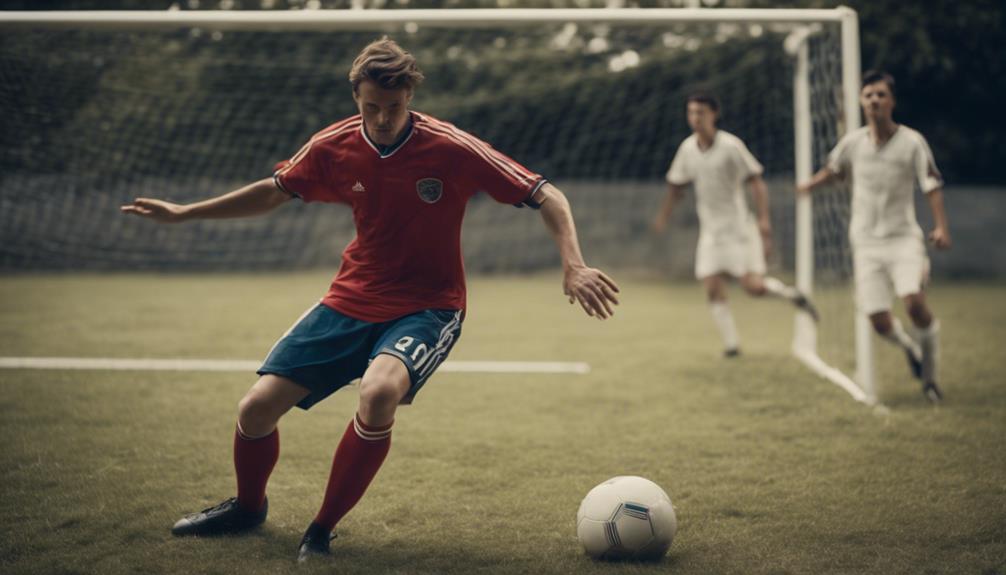
What Is a Slide Tackle in Soccer? Techniques and Safety
July 29, 2024Mastering the slide tackle in soccer involves sliding next to opponents with one leg out to contact the ball. Keep balance by bending the other leg. Maintain focus on the ball for accurate timing and distance. Keep your tackling foot low for a clean tackle. Land on your hip for control. Remember, safety is paramount. Execute the tackle with caution and control to prevent injuries. These techniques are essential for a successful slide tackle on the soccer field.
Understanding the Slide Tackle Technique
To understand the slide tackle technique in soccer, focus on the fundamental mechanics involved in executing a successful tackle. Slide tackles are an important part of the game, requiring precision and skill to execute effectively.
When performing a slide tackle, players must slide on the ground next to the opponent, extending one leg to make contact with the ball. It's essential to bend the opposite leg slightly to maintain balance and avoid two-footed challenges, ensuring safety for both players involved.
Keeping your eyes on the ball is key to a successful tackle, as it helps in maintaining the correct angle and distance for the slide. The tackling foot should be kept low, aiming for clean contact with the ball to guarantee a successful execution.
Proper Execution of Slide Tackling
For a successful slide tackle in soccer, ensuring proper execution is vital. When performing a slide tackle, bend the leg closest to your opponent to facilitate quick recovery and extension.
Extend your tackling foot slightly to the side to prevent direct impact on the opponent, focusing on making contact with the ball using your dominant leg.
Keep your eyes on the ball throughout the tackle, ensuring precise timing and execution.
After completing the slide tackle, aim to land on the hip of your extended leg for better control and a swift recovery.
Maintaining a low position with your cleats down is essential to avoid penalties and injuries while executing this essential skill in soccer.
Safety Measures During Slide Tackles

Implementing safety measures during slide tackles is essential to prevent injuries on the soccer field. To tackle safely and effectively, it's important to focus on performing a slide with the proper technique.
Essential defensive skills involve making sure you avoid using excessive force when executing a slide tackle. Remember, the primary objective should be to cleanly contact the ball, rather than endangering the opponent.
When coaching soccer, emphasize the importance of caution and control during slide tackles to minimize the risk of harm to both parties involved. By adhering to the rules and regulations governing slide tackling, you contribute to a safer playing environment for all athletes on the field.
Prioritize safety by approaching slide tackles with care and precision, keeping in mind that the well-being of players is paramount in every game situation.
Differentiating Slide Tackle Types
Differentiating between slide tackle types involves mastering specific techniques and understanding their strategic applications on the soccer field.
There are different types of slide tackles: the block tackle, side block tackle, and traditional sliding tackle. The block tackle is effective when an attacker is moving directly towards you, allowing you to block their path effectively.
Side block tackles are useful for situations where attackers are moving diagonally past you, requiring a sideways approach to impede their progress.
Traditional sliding tackles are typically considered a last resort skill, utilized when attackers have broken through the defense and need to be stopped urgently.
Each type of slide tackle demands specific techniques and precise body positioning to be successful in disrupting the opponent's advance. By recognizing the situations where each type of slide tackle is most effective, you can enhance your defensive capabilities on the field.
Enhancing Slide Tackle Effectiveness

To enhance your slide tackle effectiveness, focus on maintaining proper body positioning.
Timing your tackles with speed is crucial for a successful slide tackle.
Targeting the ball with precision is key to winning possession during a slide tackle.
By mastering these key points, you can increase the success rate of your tackles and disrupt opponents' plays more effectively on the field.
Proper Body Positioning
For improved effectiveness in executing a slide tackle in soccer, ensuring proper body positioning is essential. To achieve this, start by bending the leg closest to the opponent to facilitate a quick recovery post-tackle.
As you slide in, extend your tackling leg slightly to the side to avoid direct impact and maintain balance. Upon making contact with the ball, aim to land on the hip of the extended leg for better control and stability during the tackle.
Remember to keep your cleats down while sliding to prevent penalties and minimize the risk of injuries. It's vital to maintain a fluid motion throughout the tackle, seamlessly shifting from the initial bend to connecting with the ball.
Timing and Speed
Improving your slide tackle effectiveness hinges on mastering the timing and speed of your defensive maneuvers on the soccer field. In slide tackles, timing is essential as it dictates the success of your tackles and reduces the chances of committing fouls or causing injuries.
Speed is equally vital, enabling defenders to reach the ball ahead of opponents or block shots effectively. By combining proper timing and speed, you can anticipate your opponent's actions, leading to well-executed slide tackles.
Quick thinking and fast reactions are essential in dispossessing opponents and regaining possession swiftly. Achieving a balance between timing and speed in slide tackles can have a significant impact on your defensive plays, providing you with the ability to make decisive tackles and thwart opposing attacks effectively.
Mastering the art of timing and speed in slide tackles will enhance your overall defensive performance on the field.
Targeting the Ball
Enhance your slide tackle effectiveness by mastering the art of targeting the ball with precision and timing.
When executing a slide tackle, the key objective is to make clean ball contact to dispossess opponents efficiently. Proper technique involves extending your foot to hit the ball with the laces of your boot. By focusing on targeting the ball, you not only increase your chances of successfully winning possession but also reduce the likelihood of committing fouls or causing injuries during the tackle.
To enhance your slide tackle effectiveness, aim to strike the ball with precision and perfect timing. Hitting the ball accurately with the right amount of force can disrupt your opponent's play and create scoring opportunities for your team.
Common Mistakes to Avoid
To prevent unnecessary fouls and injuries, steer clear of common mistakes when executing a slide tackle in soccer.
Avoid lunging in with both feet as this can result in serious fouls and injuries.
It's essential to refrain from sliding in from behind the opponent, as this is considered dangerous and likely to lead to a foul being called.
Mistiming the tackle is another mistake to avoid, as it can result in receiving yellow or red cards for reckless play.
Using excessive force during a slide tackle should be avoided at all costs, as it endangers both players and can result in penalties.
Remember not to solely focus on the opponent's legs; instead, aim for the ball to prevent unnecessary injuries and fouls.
Conclusion
As you perfect the art of the slide tackle in soccer, remember to stay grounded like a tree with deep roots. Embrace the technique, execute it safely, and watch your game flourish like a blooming flower.
By avoiding common mistakes and honing your skills, you'll become a force to be reckoned with on the field. So, slide into action with confidence and let your tackles speak volumes on the pitch.


